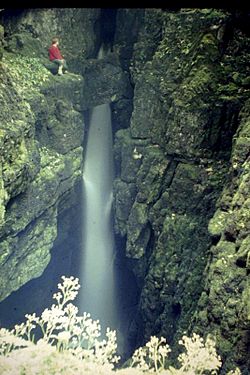Weathercote Cave facts for kids
Quick facts for kids Weathercote Cave |
|
|---|---|
 |
|
| Location | Chapel-le-Dale, North Yorkshire, [UK] |
| OS grid | SD 7393 7756 |
| Depth | 33 metres (108 ft) |
| Length | 762 metres (2,500 ft) |
| Elevation | 262 metres (860 ft) |
| Geology | Carboniferous limestone |
| Entrances | 1 |
| Difficulty | III |
| Hazards | water, loose boulders, verticality |
| Access | By prior arrangement |
Weathercote Cave is a cool natural cave found in Chapel-le-Dale, North Yorkshire, England. People have known about this amazing cave for a long time, since the 1700s! It used to be open for visitors who paid a fee, but this stopped in 1971. The main way into the cave is a big hole in the ground, about 20 metres (66 ft) deep. A powerful waterfall crashes into this hole, making it a truly special sight. The cave is also part of the important Ingleborough Site of Special Scientific Interest, which protects its unique nature.
Contents
Exploring Weathercote Cave's Wonders
The entrance to Weathercote Cave is in the Chapel-le-Dale valley, near a place called the Hill Inn. A strong wall surrounds the entrance, and a path leads from a doorway to the open shaft. This shaft is quite large, about 61 metres (200 ft) long and up to 15 metres (49 ft) wide.
The Amazing Waterfall and Underground River
An underground stream called Winterscales Beck flows into the cave. It drops about 20 metres (66 ft) down the shaft, creating the stunning waterfall you see at the entrance. Above the waterfall, there's a huge rock that looks like it's stuck, known as Mohammed's Coffin.
Inside the Cave: Passages and Connections
At the front of the shaft, there are 51 steps that go down under a natural rock arch. At the bottom, you'll find several short passages. Most of these lead to "sumps," which are parts of the cave filled with water. One of these sumps connects Weathercote Cave to another nearby shaft called Jingle Pot. Jingle Pot is about 140 metres (460 ft) further down the valley. Even further, about 200 metres (660 ft) away, is Hurtle Pot, which is also connected.
The total length of all the explored passages in this connected cave system is 2,370 metres (7,780 ft). The deepest point is about 64 metres (210 ft) down. You can follow the water upstream from the waterfall through smaller, watery passages and tiny rooms. When there's a lot of rain, the entire shaft of Weathercote Cave can fill up with water and even overflow!
How Weathercote Cave Was Formed
Weathercote Cave is carved out of Lower Carboniferous limestone. This type of rock is common in the area. The cave is part of the underground path of Winterscales Beck. This stream disappears into the ground at a spot called Haws Gill Wheel, about 1,000 metres (3,300 ft) upstream from Weathercote Cave.
The River's Journey Underground
The water flows through a mostly flooded cave system. When the river reached a big crack in the rock, called a cross joint, at Weathercote, it dropped down to a lower level. Over time, the roof of this underground passage collapsed, creating the large open shaft we see today.
The underground stream continues its journey. It flows through the bottom of Jingle Pot and Hurtle Pot, the two other surface shafts. Finally, the water comes back to the surface at a place called God's Bridge, about 1,300 metres (4,300 ft) further down the valley.
A Lost Bonnet and a Cave Connection
People discovered the connection between Weathercote Cave and Hurtle Pot a long time ago. In 1770, a woman lost her bonnet in Weathercote Cave. Later, it was found in Hurtle Pot! This showed that the two caves were linked underground.
A Look Back in Time: Weathercote Cave's History
Weathercote Cave has been famous for centuries. The first detailed description of the cave was written by Richard Pococke in 1751. He said it was "one of the most extraordinary and surprizing scenes I have ever beheld."
A Popular Tourist Spot
In 1780, John Hutton wrote about the cave, calling it "the most surprising natural curiosity in the island of Great Britain." After this, Weathercote Cave became a very popular place for people to visit. It was even featured in most guidebooks about the area.
Famous Visitors and Artists
- The famous artist J. M. W. Turner visited the cave in 1808. He drew many sketches and painted a view from the bottom of the cave. He returned in 1816 to paint the view from the top when the river was overflowing.
- In 1818, William Westall created a book of engraved views of Yorkshire, which included five pictures of Weathercote Cave.
- The poet William Wordsworth described it as a "fine object" in 1835.
- By 1858, tourists were paying to see the cave.
- In 1875, John Ruskin described it in a very dramatic way, calling it "the rottenest — deadliest— loveliest — horriblest place I ever saw in my life."
Access Changes
For many years, people could visit Weathercote Cave. However, in 1971, access became restricted after an accident involving a falling rock. Since then, you need to arrange your visit beforehand. The underwater connection between Weathercote Cave and Jingle Pot was fully explored in April 1986 by members of the Cave Diving Group.

